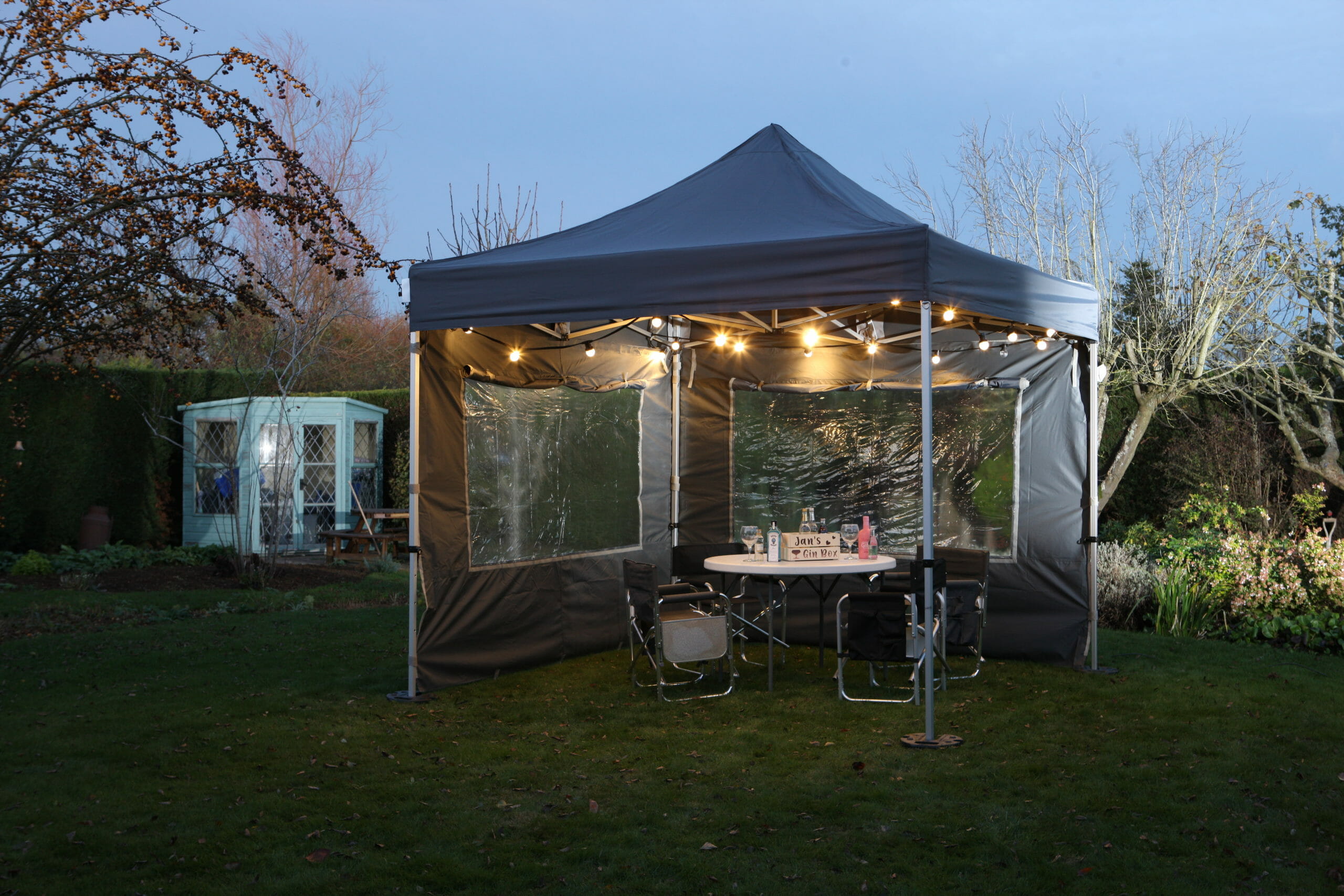How To Protect A Gazebo In Winter

After a summer of friends, family, market stalls, parties, BBQs or you name it – it’s about time to start thinking about how to protect your gazebo in the winter.
Whether you’ll be braving the cold weather and using your gazebo throughout winter or you’ve had your fun over summer and it’s now time to store it away til next year, there are a few additional steps you must take when it comes to gazebo care and maintenance.
We’ve compiled a list of easy maintenance and storage tips to protect your gazebo in winter. Keep reading and you’ll be sure to keep your gazebo as good as new all year round.
Can you keep a gazebo out in the winter?
There are many soft-top gazebos which have been carefully designed for use across all seasons, such as our Aluminium Extreme 50 HEX Series gazebo. So the answer is, yes – it is possible with the right material.
However, it’s still essential that you take good care of both the frame and canopy to prolong the lifespan for as long as possible. It’s also recommended that you don’t keep your gazebo out for long periods of time, storing it away safely when not in use.
If you’re planning to keep using your gazebo throughout the colder, wetter and windier months, keep reading for our expert maintenance tips. If you’d like to learn how to properly store your gazebo over winter, jump to later on in this guide.
Thoroughly clean the gazebo
With a change in season, it’s a good opportunity to give the gazebo a thorough clean. With regular use over the summer months, you’ll likely have entertained guests or customers, meaning the canopy and/or sidewalls could be covered in spilt food, drinks or general dirt.
If left without cleaning, the canvas canopy or sidewalls are at risk of becoming mouldy or stained, especially in the damper months.
If you’ve kept up with regular cleaning over the summer, you may be able to wipe them clean with warm and soapy water whilst it’s still hanging on the frame. However, for the most effective clean, you’ll need to remove the canopy and/or sidewalls and clean them with a soft scrubbing brush and warm, soapy water. You can then quickly hose down with clean water to remove any residue.
Top tip for winter: If your gazebo canopy is not already protected with a waterproof coating, you may want to administer your own with a suitable waterproofing spray. You can find out how to properly clean and waterproof your gazebo in our helpful guide.
Cover or remove furniture
If you have any garden or trader furniture within your gazebo, consider covering them or removing them altogether.
In the winter, it’s likely to be much wetter and windier which could cause your furniture to become damaged or damp. If it’s particularly windy, the furniture could even be thrown around causing damage to the gazebo frame
Ultimately, if you’re keeping your gazebo outside, keep an eye on the weather forecast and make reasonable adjustments to keep everything secure and suitably protected. If it’s going to be cold, find out how to heat a gazebo in winter in our helpful blog.
Watch out for debris or snow

As summer turns to autumn and autumn turns to winter, your gazebo may find itself covered in leaves, branches and debris.
Rotting leaves which haven’t been removed from the canopy can actually cause damage to the waterproof coating, so make sure to regularly clear the top of your gazebo to maintain it’s protection.
Another risk to watch out for is pools of rain or snow weighing down the structure. While freshly fallen snow glistening on the top of your gazebo may look pretty, it can be deceivingly heavy and end up tearing the canopy or collapsing the frame.
Finally, as we mentioned earlier, it’s important that you only keep your gazebo outside when it’s in use. Leaving your gazebo out in harsh weather conditions for long periods of time can cause unnecessary damage. Keep reading to learn our gazebo winter storage tips.
How to put a gazebo away for the winter
Taking down and storing a gazebo is quick and easy, especially with our pop-up gazebos which can be taken down in under a minute!
While you may be tempted to stash the gazebo away as quickly as possible, you must follow the below steps if you want to keep your gazebo in a good quality ready for summer next year. There would be nothing worse than preparing for the first sunny day of next year, only to open the gazebo and find it covered in mould and mildew due to incorrect storage.
Fortunately for you, that doesn’t have to be the case.
1. Deep clean the frame, canopy and sidewalls
Deep cleaning the gazebo frame, canopy and sidewalls is a crucial step you must take before storing them away for the winter. As you’ll be keeping the canopy and side walls wrapped up in a storage bag, any dirt, food or spillages could cause discolouration, mould or an unpleasant smell.
For the best clean:
- Remove the canopy and sidewalls from the frame and lay them out on the floor
- Wipe down the frame with warm, soapy water and sponge
- Wash the canopy and sidewalls with warm, soapy water and a soft brush, making sure to catch any stains
- Rinse the canopy and sidewalls down with clean water from a hose
- Important: Leave the entire structure out to dry in the sun, or failing that, overnight in a dry area such as a shed
2. Make sure the canvas is completely dry

Before storing the gazebo, it is essential that both the frame, canopy and sidewalls are completely dry.
Quite simply, packaging away a wet or damp gazebo is a sure way to attract mould, mildew and discolouration, giving you a nasty surprise when it’s time to bring it back out next year.
If your gazebo has been out in the rain, you will need to take it somewhere dry to remove any moisture. Don’t rush the process and you will save yourself time and costly damage.
3. Follow instructions for correct storage
The majority of our gazebos come with a free storage bag which is designed to keep your gazebo dry and protected – if stored correctly, of course.
If you still have your instructions which would have been supplied with the initial purchase, give these a read to follow any specific storage instructions. If you don’t have these anymore, don’t worry, simply read the following guidance:
Make sure to carefully place the dry gazebo into the bag without unnecessary force to avoid damage to the bag, frame or canopy. Once safely in the bag, you’ll need to find a cool, dry area to store it with enough space to avoid tearing the bag. Remember to make it easily accessible ready for the first sunny day of next year!
Although the days are getting shorter and the nights are getting colder, by following these steps you’ll have no worries when it comes to protecting your gazebo in winter. For more helpful guidance on gazebos, take a look at our news, resources and blogs.




